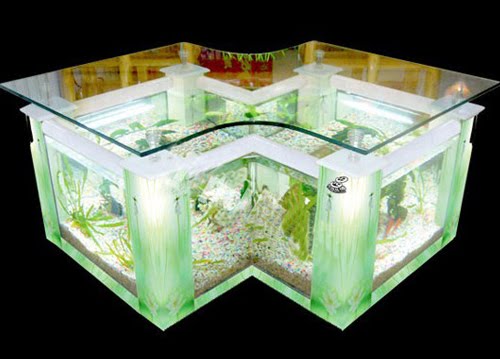Freshwater Aquarium Tank - What to Buy and How to Set it Up
Wednesday, August 24, 2011
Other
Acrylic Aquarium,
freshwater aquarium,
freshwater aquarium tank,
Glass Aquarium
 Exactly where will you put it?
Exactly where will you put it?
The size of your new freshwater aquarium tank will depend upon exactly where it will go in your property so this must be your initial decision. Keep the tank away from direct sunlight considering that this will nearly constantly encourage excessive algae growth. Also you should not location the tank where it will be tricky to sustain the correct stable temperature, e.g. near draughts from windows and doors or near radiators. In an perfect world your aquarium ought to be situated in a reasonably tranquil part of your home exactly where the fish will not be unduly alarmed by human site visitors or noise.
Acquiring your Freshwater Aquarium Tank and Equipment
Acrylic or Glass Aquarium?
As a common rule acrylic tanks are costlier than their equivalent in glass. Just for the reason that glass is more affordable it does not mean that acrylic is better than glass. Every single material has a number of positive aspects and disadvantages. Poor scratch resistance is the greatest disadvantage of acrylic. Acrylic tanks have the major benefit that they can be formed in almost any shape. On the other hand glass is tougher to scratch but it can smash and crack also it weighs a lot more mainly because it has to be thicker.
Here is a list of Acrylic Fish Tanks vs Glass Aquariums pros and cons :
Acrylic Aquarium
- Very easily scratched
- Light
- Hard to break or crack - kids safe
- Can be moulded into just about any shape
- Wants a stand supporting the complete of its weight otherwise it can split with the weight of the water
- Thinner and simpler to drill by means of for filters etc.
- Less distortion given that it is thinner
- Can yellow with age
- Additional pricey
Glass Aquarium
- Challenging to scratch
- Heavy
- Can break or crack - may well be a hazard when youngsters are about
- Restricted to certain shapes mostly rectangular while bowed front glass tanks are now readily available
- Extra rigid so they can be placed on an open stand
- Thicker and hard to drill through
- Even more distortion due to its thickness
- Does not yellow with age so they preserve clarity over a long time
- Much less expensive
Acrylic tanks have to be alot more cautiously maintained than glass making use of acrylic safe tools especially those utilised to scrape off algae.
To sum up, If you just want a regular rectangular tank then it is almost certainly best to go with glass. You will commonly have to go with acrylic if you want a particularly significant tank or one with an unusual shape.

Other Equipment
You should cautiously choose the correct equipment for your aquarium. A reputable dealer will aid you with this and it is a decent idea to develop up a decent relationship with your fish man.
You ought to have some knowledge about what else is necessary, filter, heater, lid with lighting, substrate, backing material and such things as rocks and genuine or plastic plants. You will require additional accessories like a water conditioner, net, test kits etc as soon as the tank has been set up.
The Golden Guidelines
- By no means acquire the tank and fish on the exact same day. Curb your impatience to come property with every thing you want all at when!
- Get the largest tank that space and your budget makes it possible for. Little tanks sold as perfect for beginners are a mistake. Larger tanks are more stable in terms of their water chemistry, temperature, etc. Water conditions will take longer to alter in a big volume of water so modifications for the worst are much less likely to take you by surprise. A 3 foot long (92 cm) aquarium holding roughly 100 litres (about 25 gallons) of water is a fine size starter tank.
- Preferably spot your tank on a tailor created stand, failing this it need to be a strong piece of furniture. A massive tank full of water weighs an huge amount. Water weighs 1kg (2.two pounds) per litre. A normal tank size, say 36x12x18 weighs approximately 110kg or 242 lbs plus the weight of the tank, gravel, lid and decor.
- Prepare your tank and have it running with freshwater aquarium plants, heating and filtration for at least a week before the fish arrive. This provides the water a chance to settle down as far as its quality is concerned and makes it possible for the wonderful bacteria a likelihood to multiply to a level exactly where the tank is 'cycling'.
- Do not load the tank with more than 1 inch of fish to each gallon of water and remember that your new fish are likely babies so they will grow fast. There are a number of aquarists who like to be even far more conservative employing 1 inch of fish for every single two gallons of water keeping fish waste levels low.
- Don't just tip them in add your new aquarium freshwater fish cautiously. Float the bag in the aquarium for about 20 minutes so that the temperatures equalise, open the bag and add some aquarium water to it for a further 20 minutes and then finally gently add them to the tank.
Conclusion
So what you have to do before you buy freshwater aquarium tank. Very first make a choice about where your fish tank is going to live and then you can decide on its size and the material that it is to be produced from. Your home freshwater aquarium will be a success from the start off if you follow the six golden guidelines.









